Interesting Facts About the British Pacific Fleet in WW2

HMS Aircraft Carrier - Illustrious
The fate of European colonial possessions in Asia and the Pacific was sealed in June 1940 when France surrendered to Germany. The British Expeditionary Force was also caught up in this disaster when they were forced off the European Continent. The Japanese Empire, which had been embroiled in a near decade war with China, were able to take advantage of the Europeans misfortunes. The Japanese soon began their “Greater East Asia Co-Prosperity Sphere.”

Admiral of the Fleet - Sir Alfred Dudley Pickman Rogers Pound
Defeated by the Germans, the French and Dutch were the most vulnerable. The French in “Indochina”, and the Netherlands in the “Dutch East Indies”. The Japanese moved quickly on Indochina, in particular, North Vietnam, to severe the Kunming-Hai Phong Railway from the port of Haiphong, which ran through the capital of Hanoi. The goal was to cutoff international aide to China and tap into its resources that the Japanese lacked. Likewise with the Dutch East Indies. While the British remained undefeated, they were certainly in a precarious situation, as the Germans were poised to invade the British Isles. While the Dutch and the French could offer no resistance at all, the British had one of the most powerful navies in the world. As strong as the Royal Navy was, the one thing it couldn’t do was to be in two places at the same time. In assessing its dire situation, the British made the painful decision to allocate most of its war assets in Europe to protect the home island, keep the Atlantic sea-lanes open to its North American lifeline, and blockade the German Navy from getting out in the open Atlantic and attacking merchant shipping.
The Japanese were aware of the German-Soviet Nonaggression Pact, between Russia and Germany, and were hesitant to anger the Russians by occupying all of French Indochina. The equation changed with the Nazi invasion of the Soviet Union in late June 1941. With the Soviets tied down, the Japanese high command concluded that a "strike south" would solve Japan's problems with the United States, most notably the increasing American concerns about Japan's moves in China, and the possibility of a crippling oil embargo on Japan. To prepare for an invasion of the Dutch East Indies, some 140,000 Japanese troops invaded southern French Indochina on 28 July 1941. French troops and the civil administration were allowed to remain, albeit under Japanese supervision. As events continued to unveil, the true intentions of the Japanese became crystal clear on November 26, 1941, when they set sail from the Home Islands to attack the Americans at Pearl Harbor.

Tripartite pact between Germany, Japan, and Italy
On December 7, 1941, Japan released a whirlwind in the Far East and Pacific. First by attacking the American possession of Pearl Harbor, Hawaii, followed up by attacks on Wake, Guam, and the Philippines. On December 8, 1941, they invaded the British colonial possession, Hong Kong. Sir Mark Aitchison Young, Hong Kong Governor surrendered Hong Kong on December 25th. Young was interred for the duration of the war. In January 1942 the Allies formed the American-British-Dutch-Australian Command, led by General Archibald Wavell, to co-ordinate Allied forces in Southeast Asia. Japan attacked the Dutch East Indies (modern day Indonesia) on December 8, 1941. After a four month battle the East Indies surrendered on March 9, 1942. One of the most stinging defeats occurred with the defeat of the British possession, Malaya. Malaya, which is south of modern-day Thailand, the Japanese landed troops on the eastern shore and proceeded south and marched down the western side from Thailand with the intent of taking the crown jewel, Singapore. The British Commonwealth forces were led by Lieutenant-General Arthur E. Percival. Despite a two to one advantage in the number of troops, the British lacked modern equipment to deal with a battle-tested and tenacious enemy led by Lt Gen Tomoyuki Yamashita, Commander of the Japanese 25th Army. British Lieutenant-General Percival was forced to surrender 136,000 men in Singapore to the Japanese Army. Percival, too, was interred for the duration of the war. It was here to that the Royal Navy suffered a terrible loss when the Battleship, HMS Prince of Whales and HMS Battlecruiser Repulse were sunk on December 10, 1941in the South China sea by Japanese airpower.
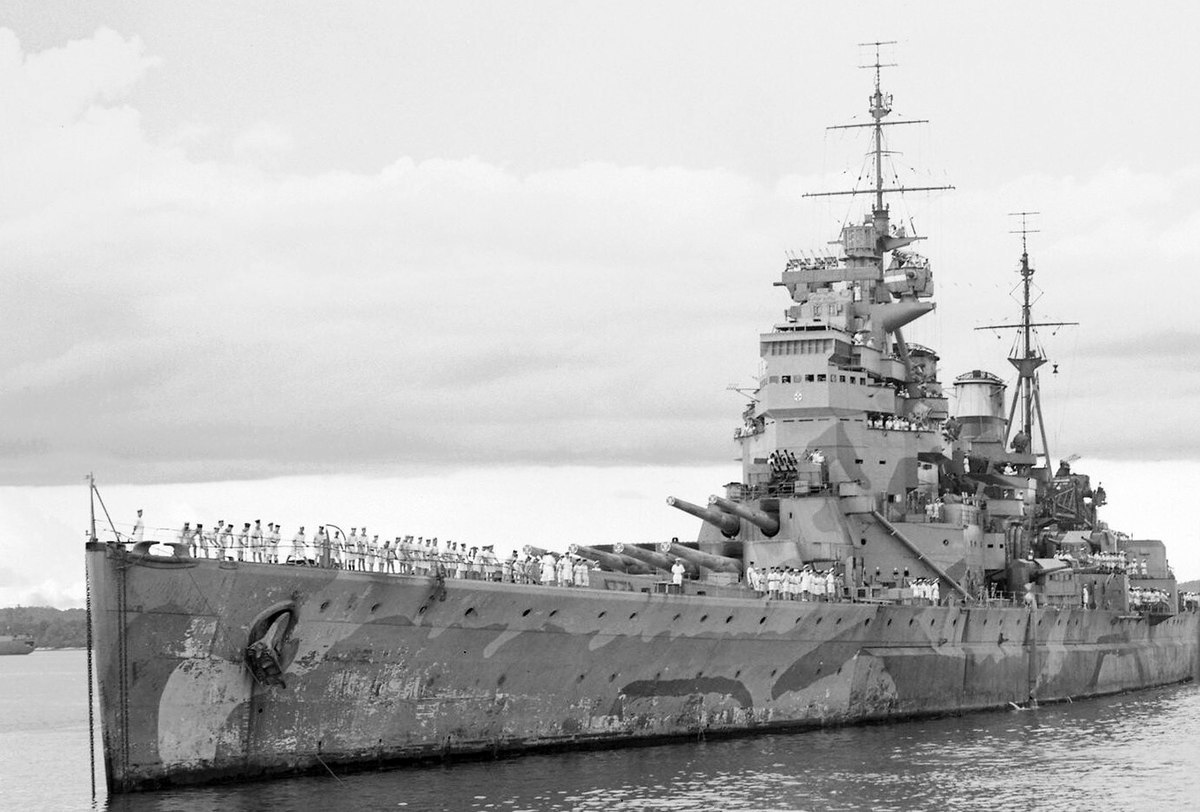
HMS Prince of Wales
As bad as the situation was, there was now a ray of hope for the British with the entry in the war of the United States. What was needed was a plan to halt the Japanese aggression until the might of U.S. industry could begin in earnest. For the Japanese, the time was now to complete their conquest of the Far East. The Japanese were intent on totally pushing the British out of Asia. The most likely place to begin this strategy was the island of Borneo and Burma (modern day Myanmar) on the mainland. The Japanese invaded in January 1942, and captured the capital city, Rangoon in March 1942. Now the Japanese would launch one of their most ambitious plans by marching west to attack the British most prized possession, India. The Japanese had several goals in mind in attacking India. First and foremost was close the Burma Road that the Allies were utilizing to supply China from India. Second, the Japanese hope to incite and uprising in India to assist throwing off colonial rule by the British. For the British, the loss of India would be catastrophic. The Japanese were intent on controlling the Indian Ocean, thus, blocking British access to oil fields in the Middle East, Persian Gulf and blocking supplies to forces in North Africa. This would take on greater significance after Germany declared war on Russia. This would the southern route the Allies would utilize in supplying aide to the Russians through Iran.
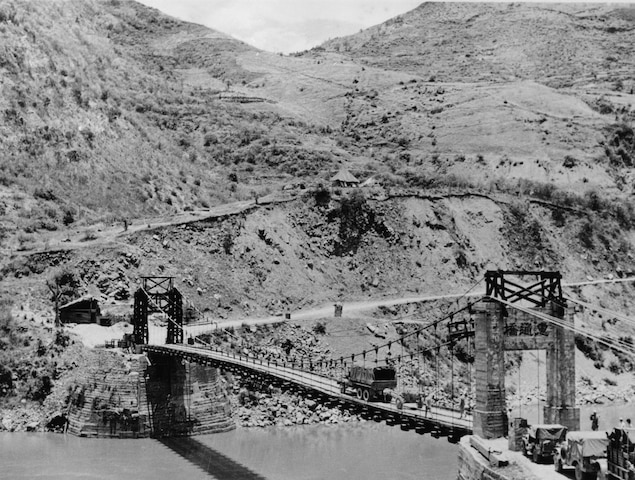
Burma Road
The Japanese battle-plan, operation “C” was the plan to attack the island Ceylon, south of the Indian sub-continent (modern day Sri Lanka). The original plan called for an all-out attack in March 1942; however, the plan was scaled back to a raid-in-force, due to forces needed to confront the United States further south. Admiral Isoroku Yamamoto assigned control of operation “C” to Admiral Nobutake Kondo. Admiral Kondo’s force was led by Admiral Chuichi Nagumo, a veteran of the Pearl Harbor raid. Nagumo had five aircraft carriers; Akagi, Shokaku and Zuikaku in Carrier Division 5, and Soryu and Hiryu in Carrier Division 2. All battle tested. The carriers were accompanied by all four Kongo-class battleships, and both Tone-class cruisers. The immediate benefit of the United States entry in the war was deployment of naval forces to the Atlantic and Europe. This allowed the British to assemble a force to confront the Japanese, at least on paper.
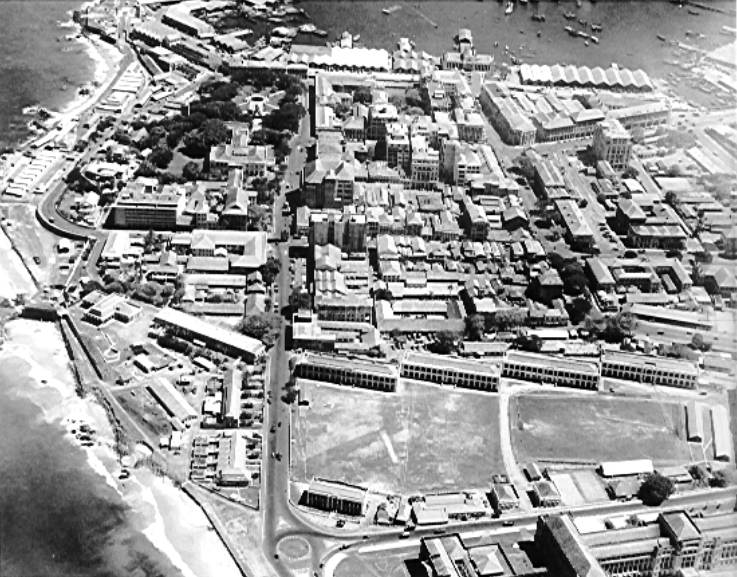
Ceylon (Now Sri Lanka)
The British naval force was given the designation the Eastern Fleet, led by Vice Admiral Sir James Somerville, who assumed command in March 1942. Somerville divided the fleet into two groups, based on the premise of speed. The faster "Force A" included the aircraft carriers HMS Formidable and HMS Indomitable, the modernized battleship HMS Warspite (his flagship), as well as modern cruisers and destroyers. The second force, the much slower "Force B" was formed around the old carrier HMS Hermes, and four unmodernized Revenge-class battleships. A few submarines were also available. The ships had never operated together before, and both ship and air crews were deficient in training. Thanks to Allied Intelligence, Admiral Somerville was aware of Japanese intentions, but wasn’t sure what strength. Admiral Sommerville’s plan was to avoid the Japanese Fleet by day and attack at night with torpedo strikes with radar equipped Fairey Albacore bombers during the night. Sommerville recognized the threat Japanese carrier-borne aircraft posed on Ceylon after the strike on Pearl Harbor, and the island's air defenses were reinforced. A contingent of Fairey Fulmars and Hawker Hurricanes were deployed for the island’s defense at Columbo and Trincomalee. A veteran of the battle Britain, the hurricanes simply could not keep up with the superb Japanese Zero fighters.

Vice Admiral Sir James Somerville
The Japanese sailed from Staring Bay on 26 March as instructed. Sommerville set out on March 30, anticipating confronting the Japanese on April 1. Sommerville deployed his fleet in a patrol area 100 miles south of Ceylon. With no sighting of the Japanese, Sommerville’s forces stood down. He reassigned several ships to protection duty at the bases. On April 4, shortly after 3:00 pm the Japanese were spotted 360 miles southeast of Ceylon. The Catalina Flying Boat that spotted the Japanese was only able to transmit partial information before being shot down. The Japanese were spotted again on April 4, by scout aircraft. The Japanese were again spotted the following day 110 miles east of Ceylon. Admiral Sommerville sailed east with “Force A”, “Force B” would follow after refueling. HMS ships Cornwall and Dorsetshire sailed to join “Force A” while the carrier Hermes was ordered Northeast of Ceylon to stay out of harm’s way.
On the morning of April 5, the Japanese were aware that the British carriers were not in the port of Columbo on Ceylon. They launched additional scout aircraft to the northwest and southwest of Ceylon. At 6:00 am Admiral Nagumo ordered a strike force of 91 bombers and 36 fighters in the air for an attack. As the Americans had seen at Pearl Harbor, the British early warning system failed to detect in incoming Japanese force. The Japanese arrived at 7:45 over the harbor. British pilots were forced to get into the air under heavy attack from Japanese fighters. The Japanese sank the armed merchant cruiser HMS Hector, the Norwegian tanker Soll and the destroyer HMS Tenedos. Several other vessels were badly damaged, but the real blow came when 20 of the 41 British aircraft were lost, several while attempting to take off. The harbor was also damaged but was able to maintain service. The Japanese lost just 7 aircraft during the attack. The size of the Japanese attack was conformation to Admiral Sommerville was facing a force of more than two carriers he had initially assumed.
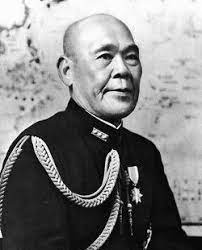
Admiral Chuichi Nagumo
The British forces misfortunes continued when Japanese scout aircraft spotted HMS ships Dorsetshire and Cornwall at 10:00 am. An attack force from the carriers Soryu and Hiryu were launched in a coordinated attack. Both British ships were sunk at 4:00 pm, with a loss of over 400 officers and crew. April 6 found each side desperately attempting to locate the other but were unable to do so. Sommerville was guided by orders from the Admiralty not to engage in any undue risk. Little did he know that in several cases there was a short distance between the two forces. This was brought home when Japanese cruisers Humano and Suzuya sank the merchant ships Silksworth, Autolycus, Malda, Shinkuang and the American vessel Exmoor. On April 9 the Japanese pressed home the attack on the port of Trimcomalee. This time the British were better prepared and had cleared the harbor the night before. The British detected the incoming attack force of 132 aircraft. Twenty-three British aircraft rose to attack the Japanese. In the ensuing battle two Japanese Zeros were shot down. Nine British aircraft were lost, the Japanese lost four. A British scout plane spotted the Japanese, and an attack by 9 unescorted Blenheim bombers was launched. The bombers arrived undetected, but the bombing run was ineffective, and 4 bombers were shot down.
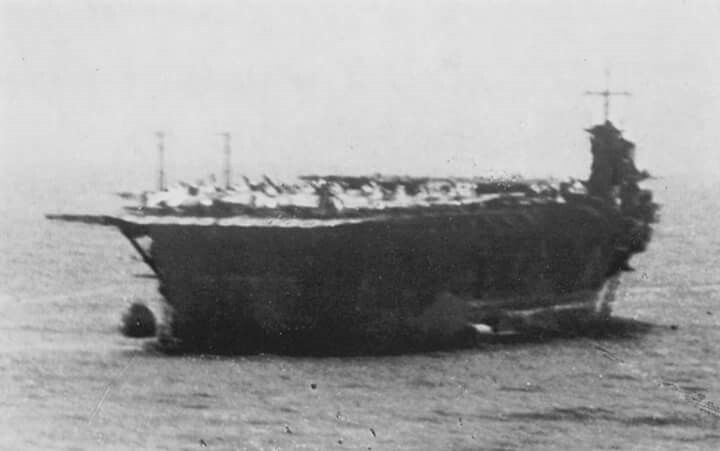
Japanese carrier Soryu
Once again, misfortune would find the British in a major way. The carrier Hermes and her escort were a short distance away from port during the attack. Japanese scout planes located the ships, and an attack ensued. At 10:30 am 80 reserve Val dive bombers attacked. The Hermes and Vampire were sunk by noon. The Hermes was hit by forty 500 lbs. bombs, with a loss 347 men and the downed Vampire lost 8 men. The hospital ship Vital, was able to rescue 600 men in the shark infested waters. The losses were staggering for the British in this engagement; one carrier, two cruisers, and twenty-three merchant vessels. In addition, the British lost a third of their ground-based fighter aircraft, and nearly all their ground-based strike-aircraft. The harbors were damaged but were able continue their service operations. After his successful attack, Admiral Nagumo withdrew his forces. Though he had achieved a great deal of success, however, like at Pearl Harbor, he failed to destroy the British carrier force. And it was apparent to Admiral Sommerville that he was up against a powerful force, but he determined that Japanese didn’t have the necessary troop transports to facilitate a land invasion on Ceylon. Guided by his instructions of not risking his forces unnecessarily Sommerville was able to avoid total disaster. Although it wasn’t known at this time, this would be the only fleet to fleet action of World War II between Japan and the British.
An event that occurred in April 1942, drew the Japanese attention away from the Indian Ocean operation. The American air raid led by Lt. Colonel Jimmy Doolittle on the Japanese home islands, brought home the fact that Americans were still a danger. As more and more men and material poured into the Pacific the British were able to pull back and redeploy Eastern fleet resources to the Mediterranean and European theaters. The Japanese were now focused on cutting the lifeline between the United States and Australia, first by their Coral Sea operation in May 1942 to establish bases on New Guinea to attack Northern Australia. Second, the Midway operation to draw out the American carriers for a decisive battle. The Americans were able to thwart the Japanese Coral Sea operation and win a spectacular victory at Midway by ambushing the Japanese and destroy 4 of their front-line carriers. The Americans followed up their success by taking and holding the island of Guadalcanal in the Solomon Islands. It was clear that by the beginning of 1943 that the tide of the war was now changing. In North Africa the Germans were on the run, The Russians were getting stronger by the day, and the U-boat menace in the Atlantic was losing ground. And it was apparent the battle in the Pacific was becoming an “American show” as they, and the Japanese were engaged in some of the most vicious fighting mankind had ever seen.
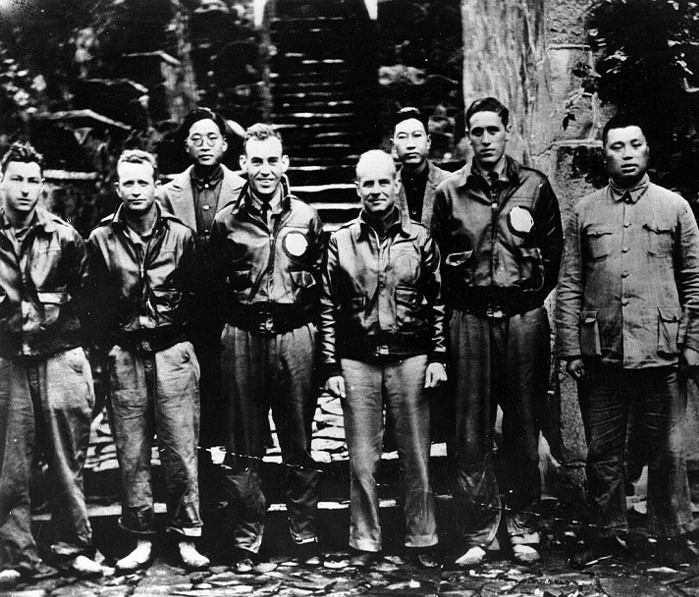
Lt. Colonel Jimmy Doolittle in China
In September 1944 the Allied leaders conducted their second high level meeting in Quebec City. President Franklin Delano Roosevelt and Prime Minister Winston Churchill met to finalize plans to bring the war to a conclusion. It was at this time that Churchill suggested that the British return to the Pacific in strength now that they had pushed Germany back in the Atlantic and Mediterranean. On November 22 the British Pacific Fleet (BPF) was formed under the command of Admiral Sir Bruce Fraser. The BPF would soon join the American fleet as operations in the Philippines got underway. The BPF was based in Sydney, Australia and at additional bases on Manus and Admiralty Islands. The BPF would be a greater than the Eastern Fleet that operated in 1942 in the Indian Ocean. The most significant change would be a change in aircraft the BPF would now utilize. A good example was the outstanding British Supermarine Spitfire. When the Royal Navy adopted a land based, or foreign fighter there would a name change. The Spitfire would become the Seafire after adjustments for carrier duty. The same occurred when the Royal Navy choose the Grumman F4F Wildcat, which became the Martlet. And when the British selected, arguably, the best fighter of World War II the North American P-51, which became the Mustang.
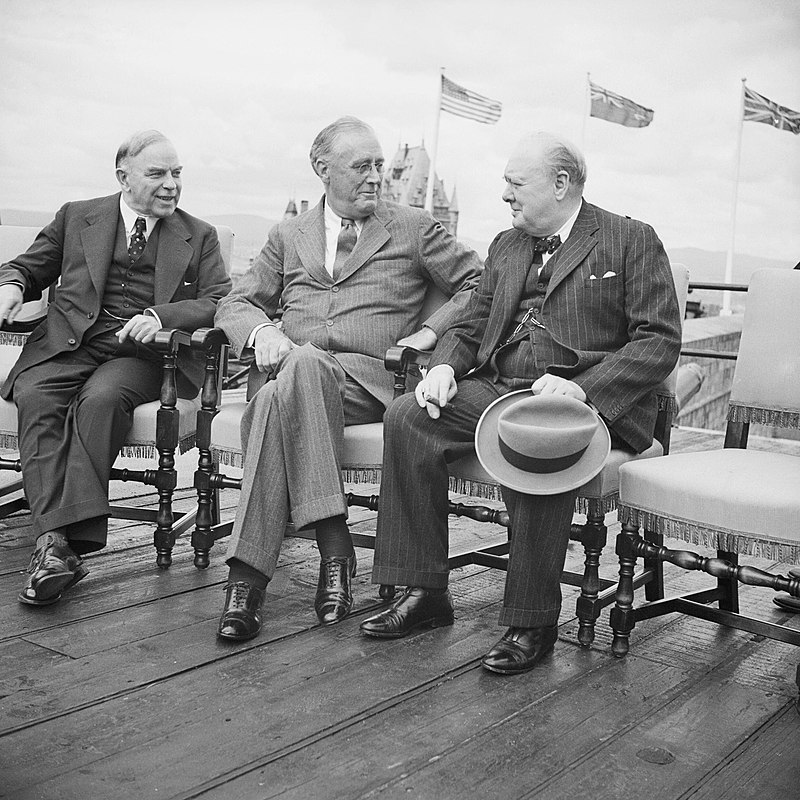
W L King, Franklin Roosevelt, Winston Churchill
The Seafire was certainly a great fighter, but the drawback was its short range. It and other British aircraft simply didn’t have the “sea legs” to cover the vastness of the pacific. It was here that the Americans were excelling with new and better aircraft that were proven and now battle tested. Primarily the Vought F4U Corsair and Grumman upgrade, the F6F Hellcat. In one engagement this fact was driven home in the June 1944 during the battle of the Philippine Sea. The battle was the Japanese Navy’s attempt to hold onto the Marianas Island. A loss here for the Japanese would mean that American heavy bombers would be in range of the Japanese home islands. An American armada of 500 ships approached the island of Saipan. The Japanese gathered available carrier force, along land-based aircraft from the Philippines to repel the American force. The American held several advantages: a string of successful recent engagements, and advanced radar. The Japanese were first to launch, they ordered a strike of 68 aircraft from the Philippines. The Americans detected them 150 miles out. The Japanese were only able to land one bomb, however, 41 Japanese aircraft were shot down.
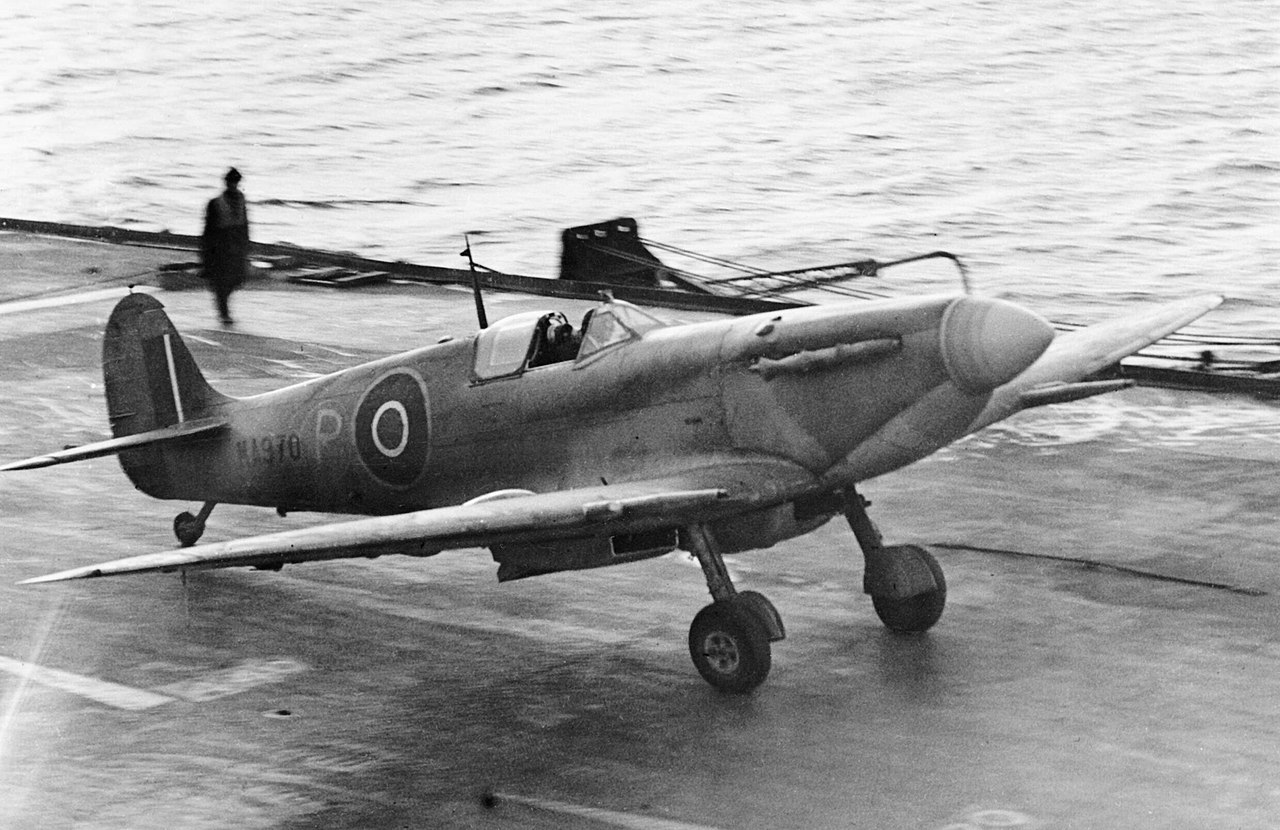
British Seafire
The Japanese immediately launched a second strike with 107 aircraft. The results were the same as the first strike, 97 aircraft were shot down. A third attack of 47 aircraft ensued, and 7 were shot down. Unbelievably, anther attacked followed this with 82 aircraft. Seventy-three Japanese aircraft were destroyed. By the end of the conflict the Japanese would lose 346 aircraft, to the American 30. In addition, the Japanese would lose 3 aircraft carriers and other miscellaneous ships. The American pilots would later tag the engagement “The Great Marianas Turkey Shoot.” The F6F Hellcat clearly demonstrated its dominance for the remainder of the war. The British Pacific Fleet eagerly adopted the F4U Corsair for carrier duty. Here, the British would demonstrate their capabilities for solving difficult problems. The Corsair was every bit as good as the F6F, however, it had proved difficult to handle in carrier landings. The Americans relegated the Corsair to land based duties. First, the British assigned the same landing pattern of the Seafire to the Corsair. Second, they determined that the hard landing problem was the result of a stiff landing gear. This was solved by replacing a valve in the strut to “soften” it up. Third, on approach to the carrier, one wing tended to stall first. This often led to crashes. This was fixed by a wedge riveted to the front of the starboard wing which fixed the one wing stall problem.
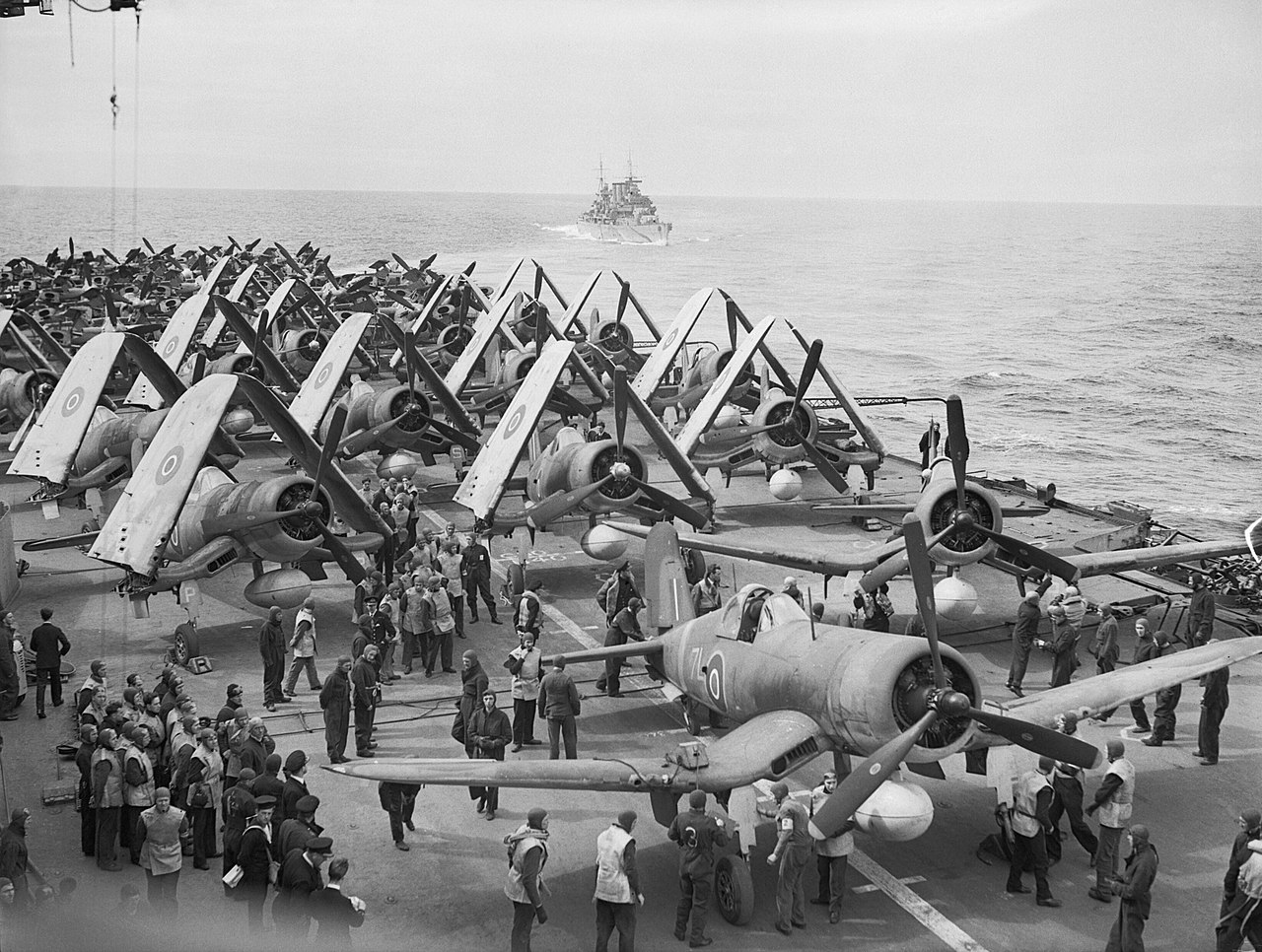
Royal Navy Corsairs
The most critical decision the Allies faced, was how to best utilize the British Pacific Fleet (Task Force 57). By now, the Americans were on a two-track approach to concluding the war. General Douglas MacArthur was in the process of fulfilling his 1942 promise to return to the Philippines and liberate Borneo. For Admiral Nimitz, who had just won a decisive battle at Iwo Jima, the island of Okinawa was now in his sights. It was finally decided that the BPF would join Admiral Nimitz’s Okinawa invasion force. After battling the Japanese for three years, the Americans were somewhat reluctant at adding the British Fleet. The Americans felt that the unit cohesion, USN tactical fleet formations, maneuvers, and communications, they had established under-fire would be interrupted. At the insistence of London, the matter was settled, they would join the fleet. While in Guam in the Marianas Islands in May 1945 the American Commander-in-Chief, Admiral Nimitz went abroad the 'King George V' to inspect the ship's Company. In his address to the ship’s company, Admiral Nimitz clearly stated his acceptance of the BPF to the rousing cheers of its crew.
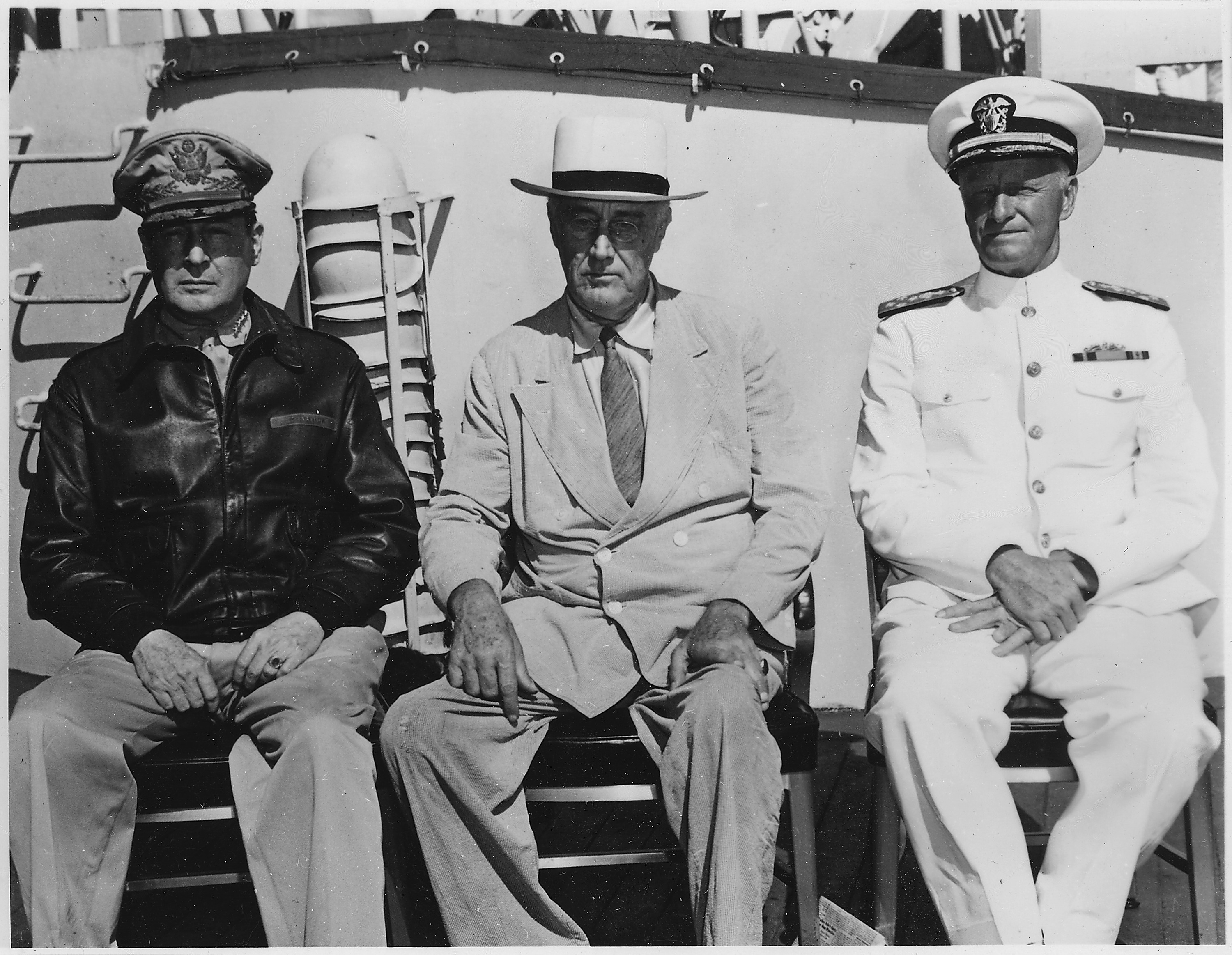
Gen. Douglas MacArthur, Franklin Roosevelt, Admiral Chester Nimitz
Admiral Fraser and the BPF arrived in Sydney, Australia in February 1945. Admiral Fraser transferred his flag ashore, and setup his command at the Grenville House. Admiral Fraser’s second-in-command Vice Admiral Sir Bernard Rawlings commanded the fleet at sea. The fleet soon set sail for Manus Island, which is part of Manus Province in northern Papua New Guinea and is the largest of the Admiralty Islands. Orders issued on March 15, 1945, directed the BPF to join Admiral Nimitz’s fleet for operation “ICEBERG” (the attack on Okinawa). On March 16 the fleet took up station near Sakishima Gunto islands, between Okinawa and Formosa (modern day Taiwan). Beginning on that and subsequent days the fleet’s carrier aircraft attacked the Japanese airfields of the group. The main American assault on Okinawa commenced on 1 April (April Fool’s Day). The British carriers next attacked the nearby Japanese airfields in Northern Formosa before returning to destroy any remaining aircraft in the Sakishima group.
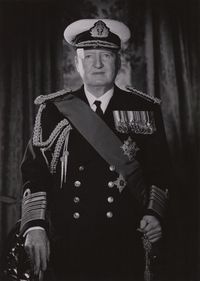
Admiral Sir Bruce Fraser
After this engagement the fleet returned to Leyte to replenish. After replenishment they returned to action on May 4, 1945. At this time of the war the Japanese fleet was unable to carry-out any significant action against the Allies. In the desperate situation they now found themselves in, the Japanese resorted more and more to kamikaze attacks. A tactic where pilots would deliberately crash their aircraft into Allied ships, sacrificing themselves to honor the Emperor. The carriers and battleships were the primary targets. On 6 April Kamikaze’s located the carrier Illustrious and attacked. Fortunately, the British carrier’s armored flight deck saved her from serious damage. For several days later the BPF was attacked again and again by intense kamikaze attacks, with four major hits on the carriers resulting in many of the aircraft on the fligh decks being destroyed. The fleet continued air operations against the Japanese at Sakishima until 25 May 1945 when the fleet returned to Manus and then Sydney. It would take three weeks in Sydney where the fleet was replenished, repaired, and refreshed. The aircraft carrier Formidable required intense major repairs after its armored flight deck was nearly ripped apart by a kamikaze attack.
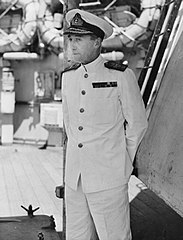
Vice Admiral Sir Bernard Rawlings
By 1944 the Americans had assembled the world’s largest naval force in history, in the pacific. Their forces were designated Third Fleet and Fifth Fleets. Their command structure was based on a rotating structure of admirals, Raymond Spurance and William “Bull” Halsey. When Admiral Spurance was in command, it was known as the Fifth Fleet, led by Admiral Marc Mitscher, and designated Task Force 58. When Admiral Halsey was in command it was designated the Third Fleet, led by Vice Admiral John S McCain (father of the late Senator John McCain) and designated Task Force 38. This massive fleet consisted of 17 aircraft carriers, 6 Battleships, 13 cruisers, 58 destroyers and an air strike force of over 1,000 aircraft, along with numerous support ships.
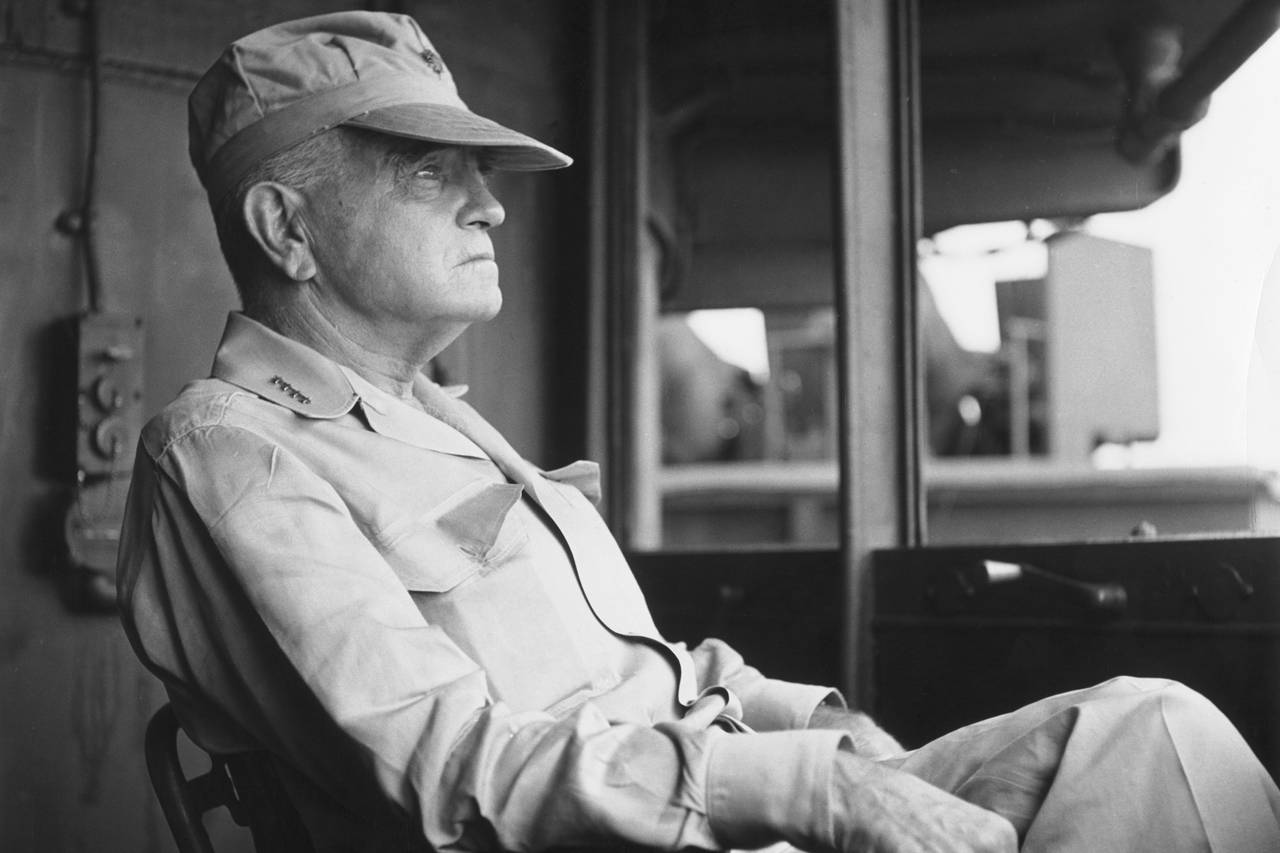
Admiral William “Bull” Halsey
The BPF return to combat duty on 28 June 1945 under orders to join the US Third Fleet, under Admiral William (Bull) Halsey (Task Force 38). Their first action occurred on July 17 when the fleet went into action with air attacks and bombardments against targets on the Japanese mainland, and these operations continued for the remaining weeks of the war. The fleet rained down destruction on many of Japan's towns, dockyards, airfields, and industries in the south-east. the US Third Fleet (including the British) moved north-east up the Japanese coast leaving a path of destruction behind it. It was during an attack on Honshu when the U.S. B-29 bomber, Enola Gay dropped the first atomic bomb on Hiroshima on August 6, but hostilities did not cease until the 11 August when Japan formally surrendered. Most of the BPF left the Japanese coast, as planned, on 12 August due to an absence of tankers for refueling. The flagship King George V and the carrier Indefatigable remained behind to attend the formal surrender ceremony in Tokyo Bay on 2 September 1945.
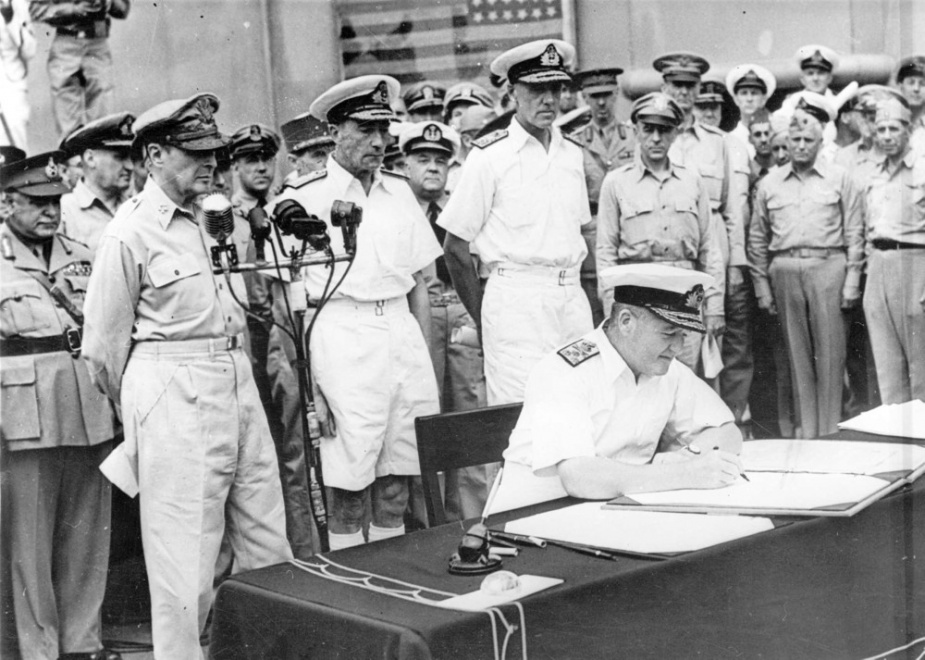
Admiral Sir Bruce Fraser aboard the USS Missouri to sign Japanese surrender
If you enjoyed this informative article, please feel to join my Facebook Group - Evolution Of WW2 Fighter Aircraft
You can now view our store apparel at our Apparel Store